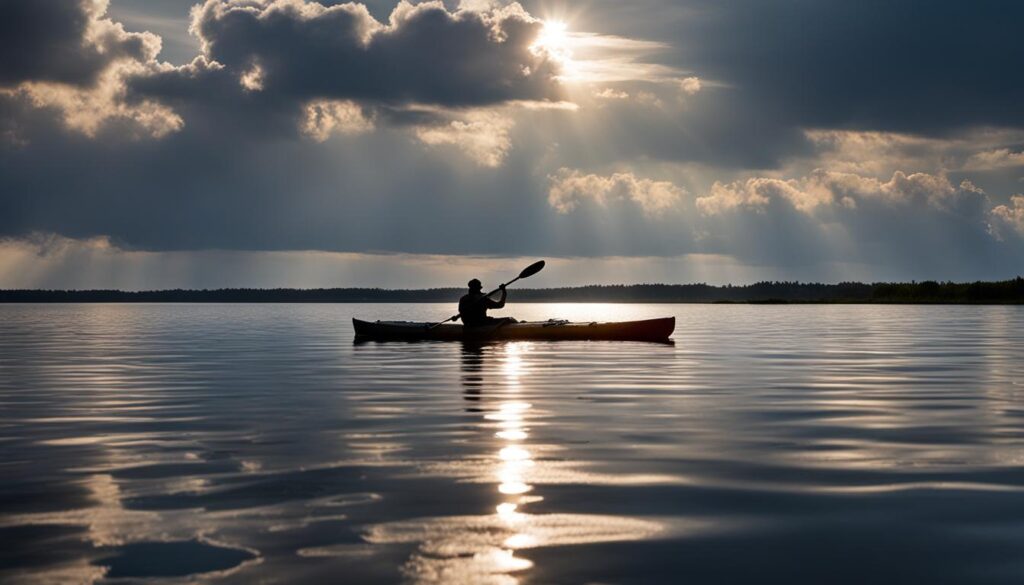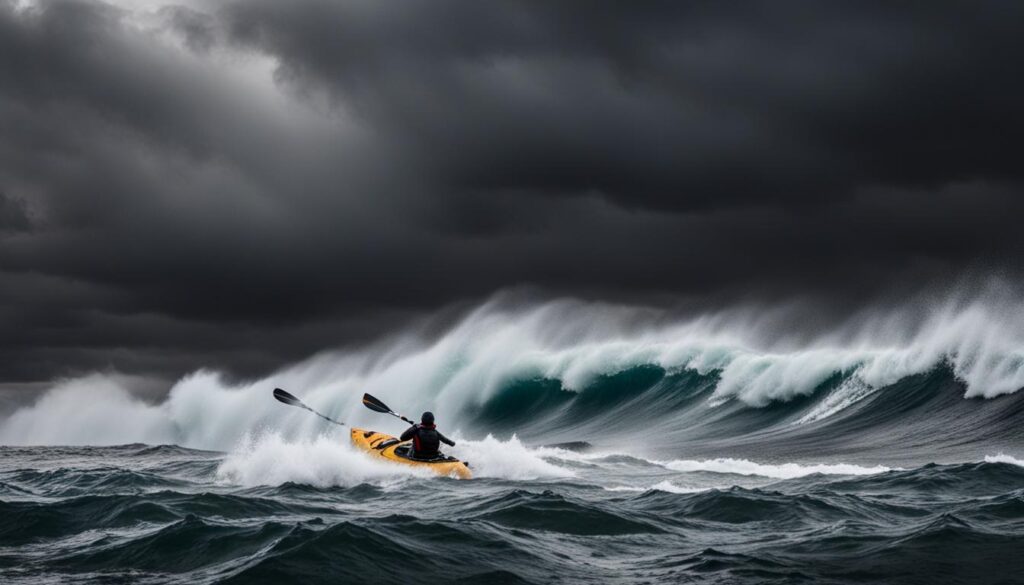Understanding how clouds and pressure systems affect the weather is essential for kayakers. Weather is created by areas of high and low pressure moving across the globe, typically in a west to east direction. Clouds are categorized by altitude, with high-level clouds indicating weather changes about a day away, mid-level clouds often signaling impending rain, and low-level clouds bringing fog or overcast skies. There are three main types of clouds for kayakers to watch for: cumulus, stratus, and nimbus. Fluffy white cumulus clouds usually indicate fair weather, while cirrus clouds suggest good weather for another day or so before changes occur. On the other hand, mackerel sky clouds may indicate fair weather for the day but possible changes within 24 hours. A lowering cloud base, thickening cirrus clouds, and grey mid-level clouds moving quickly are signs of impending wind and rain. Vertical growth of clouds, anvil-shaped clouds, and the presence of lightning can indicate the approach of storms or thunderstorms. Squall lines, which form when a cold front meets warmer air, can bring sudden and strong winds, making them dangerous for kayakers. Keeping an eye on the sky and understanding cloud formations can help kayakers make informed decisions for their safety on the water.
Key Takeaways:
- Clouds are categorized by altitude: high-level, mid-level, and low-level clouds signify different weather changes.
- Different cloud formations indicate different weather conditions, from fair weather to approaching storms.
- Understanding cloud formations and their predictions can help kayakers plan their paddling trips effectively.
- Vertical growth of clouds, anvil-shaped clouds, and lightning can indicate the approach of storms or thunderstorms.
- Squall lines, formed when a cold front meets warmer air, can bring sudden and strong winds, posing risks to kayakers.
Keep these key takeaways in mind as you continue to explore the impact of clouds and pressure systems on kayaking in the following sections.
Types of Clouds and their Predictions
Clouds can provide valuable predictions about weather conditions for kayakers. There are different types of clouds to watch for, each with its own implications. Here’s a breakdown of the most common cloud types and what they mean for kayaking:
Cirrus Clouds
Cirrus clouds, which are high-level and wispy, often indicate approaching bad or unsettled weather. These thin, feathery clouds can be seen as a warning sign for kayakers to keep an eye on the sky and be prepared for potential changes in weather conditions.
Stratus Clouds
Stratus clouds, which are pale gray or white and spread across the sky, signal a change in weather within 12-18 hours when they cover the entire sky. Kayakers should take note of these clouds as they can indicate the approach of rain or other atmospheric disturbances.
Cumulus Clouds
Cumulus clouds, which are puffy white cotton balls, can indicate fair weather for at least 24 hours if they remain the same size and shape without vertical growth. These fluffy clouds are generally a positive sign for kayakers, suggesting calm and pleasant conditions on the water.
Cumulonimbus Clouds
However, if cumulus clouds begin to tower and develop into cumulonimbus clouds, showers or thunderstorms are likely to occur within a few hours. Cumulonimbus clouds are characterized by a large dark base and a bright anvil-shaped top. Kayakers should be cautious when these clouds form, as they can bring heavy rain, strong winds, hail, and lightning, potentially making paddling conditions hazardous.
By understanding the different cloud types and their predictions, kayakers can better prepare for changing weather conditions and ensure their safety on the water.
| Cloud Type | Appearance | Prediction |
|---|---|---|
| Cirrus Clouds | High-level, wispy | Approaching bad or unsettled weather |
| Stratus Clouds | Pale gray or white, spread across the sky | Change in weather within 12-18 hours, potential rain |
| Cumulus Clouds | Puffy white cotton balls | Fair weather for at least 24 hours |
| Cumulonimbus Clouds | Large dark base, bright anvil-shaped top | Showers or thunderstorms within a few hours, heavy rain, strong winds, hail, and lightning |
It is important for kayakers to be aware of these cloud types and their predictions to make informed decisions about their paddling trips.

Reading Clouds for Weather Changes
Being able to read clouds is crucial for predicting weather changes while kayaking. Clear skies with little to no clouds indicate no change in weather conditions. Partly cloudy or partly sunny skies with loose, fluffy, cotton ball clouds known as cumulus clouds generally signify fair weather. However, if these cumulus clouds start to bunch up, forming firm edges with definite shapes, it is a sign that heavy showers may be approaching. Other cloud formations to be aware of include cirrocumulus clouds (also called “Mackerel sky”), which are considered an omen of bad weather, and cirrus clouds, which are high and wispy and often bring winds the following day. Swelling cumulus clouds, characterized by flat bottoms with growing cauliflower-like towers, can precede the formation of cumulonimbus clouds, which are towering storm clouds bringing rain, thunder, lightning, and even tornadoes. Fog, which is a cloud at ground level, can also affect paddlers by obstructing visibility and causing disorientation. By understanding the different cloud formations, kayakers can be better prepared and make safer decisions while on the water.
| Cloud Formation | Weather Significance |
|---|---|
| Cumulus Clouds | Fair weather if they remain the same size and shape. Heavy showers if they start to bunch up. |
| Cirrocumulus Clouds (“Mackerel sky”) | Considered an omen of bad weather. |
| Cirrus Clouds | High and wispy, often bring winds the following day. |
| Cumulonimbus Clouds | Towering storm clouds bringing rain, thunder, lightning, and even tornadoes. |
| Fog | Cloud at ground level, can obstruct visibility and cause disorientation. |
Cloud Formations and their Weather Significance
- Cumulus Clouds: Fair weather if they remain the same size and shape. Heavy showers if they start to bunch up.
- Cirrocumulus Clouds (“Mackerel sky”): Considered an omen of bad weather.
- Cirrus Clouds: High and wispy, often bring winds the following day.
- Cumulonimbus Clouds: Towering storm clouds bringing rain, thunder, lightning, and even tornadoes.
- Fog: Cloud at ground level, can obstruct visibility and cause disorientation.
Being able to interpret cloud formations is an essential skill for kayakers looking to stay safe on the water. By understanding the weather significance of different cloud types, kayakers can make informed decisions about when to paddle and when to seek shelter. Clear skies and cumulus clouds generally indicate fair weather, while cirrus clouds may suggest winds the following day. However, bunching cumulus clouds, cirrocumulus clouds, and cumulonimbus clouds are signs of potentially heavy showers or storms. Additionally, fog can reduce visibility and hinder navigation. By paying attention to cloud formations and their weather implications, kayakers can better prepare themselves for changing conditions and enjoy a safe and enjoyable paddling experience.
Pressure Systems and their Impacts on Kayaking
Understanding pressure systems is crucial for kayakers as they have a significant impact on weather conditions and can greatly affect paddling experiences. Two main types of pressure systems are low pressure and high pressure systems, each bringing different weather patterns and implications for kayakers.
Low Pressure Systems
Low pressure systems typically bring cloudy weather and precipitation. As a kayaker, it’s important to be aware of these systems as they often indicate the approach of unsettled weather. This can include heavy rain, stormy conditions, and even severe weather such as thunderstorms. When a low pressure system moves into a region, it’s a sign that kayakers should exercise caution and avoid going out on the water until the system has passed.
High Pressure Systems
In contrast, high pressure systems usually result in calm and sunny weather. These systems dominate the weather pattern and can bring several days of fair conditions with little to no precipitation. For kayakers, high pressure systems provide an opportunity for enjoyable and safe paddling experiences. However, it’s important to remember that even during high pressure conditions, other factors such as wind and wave conditions should still be considered before heading out on the water.
By understanding the different impacts of pressure systems on weather, kayakers can make informed decisions about when and where to paddle. Monitoring barometric pressure can also provide valuable insights into weather changes. Rising or falling pressure can indicate the approach of weather systems, allowing kayakers to plan their trips accordingly and ensure their safety on the water.
Overall, being aware of pressure systems and their effects is crucial for kayakers to have a successful and enjoyable paddling experience. By staying informed about weather conditions and understanding the implications of pressure systems, kayakers can make better decisions and mitigate potential risks while on the water.

Dangers to Watch Out for While Kayaking
When kayaking, it is important to be aware of potential dangers associated with weather conditions. Understanding the impact of weather systems and pressure changes can help you stay safe on the water. Thunderstorms are one of the most significant hazards for paddlers and should be avoided at all costs. These storms can bring heavy rain, strong winds, lightning, and even tornadoes. Always check the weather forecast before heading out and never be on the water during a thunderstorm.
Strong winds can also pose a danger to kayakers. Headwinds can create resistance and make paddling more challenging, while tailwinds can push you off course. Crosswinds can be particularly challenging, pushing you sideways and requiring extra caution. It’s essential to assess the wind direction and strength before embarking on your kayaking adventure.
Fog is another potential risk that can obstruct visibility and make navigation difficult. It’s crucial to be vigilant and use appropriate safety measures, such as using a compass or GPS device to maintain your bearings. Additionally, wearing bright, reflective clothing and using lights or flags can help other boaters see you in low visibility conditions.
| Dangers | Precautions |
|---|---|
| Thunderstorms | Avoid being on the water during a thunderstorm. Check the weather forecast before heading out. |
| Strong winds | Assess wind direction and strength before paddling. Be cautious of crosswinds and adjust your course accordingly. |
| Fog | Use a compass or GPS device to maintain your bearings. Wear bright, reflective clothing and use lights or flags for visibility. |
By being aware of these potential dangers and taking appropriate precautions, you can ensure a safe and enjoyable kayaking experience. Stay informed about weather conditions, plan your trips accordingly, and always prioritize your safety on the water.
Conclusion
Understanding how clouds and pressure systems affect weather conditions is crucial for your kayaking adventures. By learning to read cloud formations and interpret their predictions, you can make informed decisions about when to hit the water. Knowing the impacts of different pressure systems on weather can help you plan and prepare for your trips.
It’s important to be aware of potential dangers such as thunderstorms, strong winds, and fog. These weather conditions can pose risks to your safety and navigation. By staying updated on weather forecasts and reports, as well as understanding the signs and signals of changing weather conditions, you can take appropriate precautions and ensure a safe and enjoyable kayaking experience.
Remember, a key part of kayaking is being prepared for the weather. By gaining a deeper understanding of the weather system, you can confidently navigate through changing conditions and make the most of your time on the water. So, grab your paddle, stay informed, and embrace the beauty of nature while kayaking.
FAQ
How can clouds help predict weather conditions for kayakers?
Clouds can provide valuable predictions about weather conditions for kayakers. Different types of clouds, such as cirrus, stratus, cumulus, and cumulonimbus, indicate specific weather patterns. By understanding these cloud formations, kayakers can make informed decisions about their paddling trips.
What are the different types of clouds kayakers should watch for?
Kayakers should watch for cumulus clouds, which indicate fair weather; cirrus clouds, which suggest good weather for another day or so; stratus clouds, which signal a change in weather within 12-18 hours; and cumulonimbus clouds, which bring rain, thunderstorms, and strong winds.
How can kayakers read clouds to predict weather changes?
Kayakers can read clouds by observing their size, shape, and movement. For example, towering cumulus clouds and anvil-shaped clouds indicate the approach of storms or thunderstorms. Lowering cloud base, thickening cirrus clouds, and grey mid-level clouds moving quickly suggest impending wind and rain.
How do pressure systems impact kayaking?
Pressure systems play a significant role in determining weather conditions. Low pressure systems usually bring cloudy weather and precipitation, while high pressure systems tend to bring sunny and calm weather. Understanding pressure systems can help kayakers plan their trips accordingly, taking into consideration the potential for rain, wind, and other weather-related factors.
What are the potential dangers associated with weather conditions while kayaking?
Thunderstorms, strong winds, and fog are potential dangers kayakers should be aware of. Thunderstorms can bring rain, thunder, lightning, and even tornadoes, making it crucial to never be on the water during a storm. Strong winds can push kayakers off course and into dangerous obstacles, while fog can obstruct visibility and cause disorientation.





